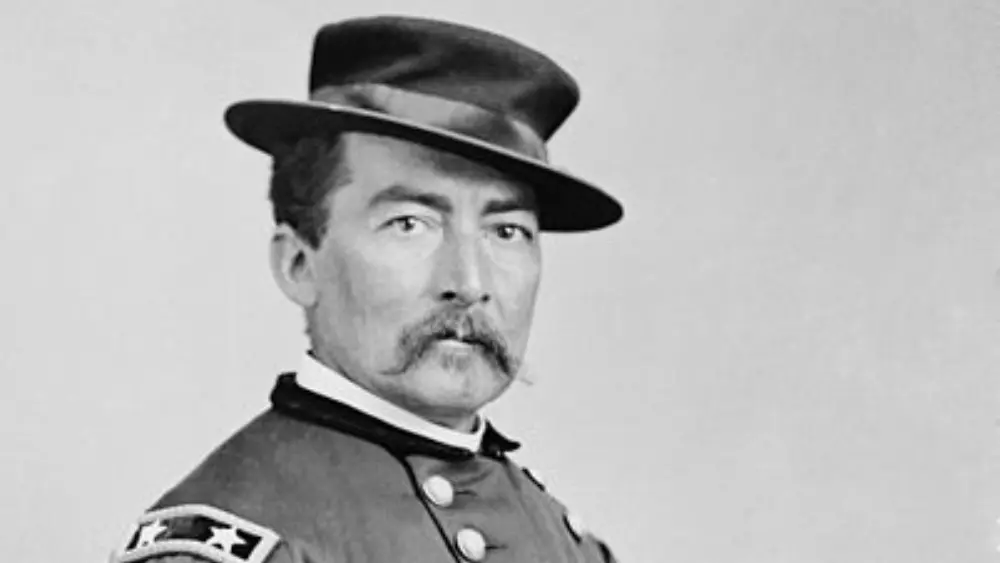Philip Sheridan, born on March 6, 1831, in Albany, New York, emerged as one of the Union Army’s most dynamic and effective leaders during the American Civil War. Renowned for his aggressive and innovative tactics as a cavalry commander, Sheridan played a pivotal role in shaping the outcome of key battles.
Early Military Career and West Point Education
Philip H. Sheridan’s military journey commenced with his admission to the United States Military Academy at West Point in 1848. Although he faced academic challenges during his time at West Point, Sheridan graduated in 1853, marking the beginning of a career that would catapult him to prominence during one of the nation’s most tumultuous periods. His West Point education not only equipped him with a solid foundation in military strategy and leadership but also instilled in him the discipline and skills necessary for navigating the complex landscape of the Civil War and the challenges that lay ahead.
Sheridan’s formative years at West Point laid the groundwork for the distinguished military career that followed. The knowledge and training he received during his education became essential as he navigated the complexities of the Civil War and rose through the ranks, ultimately becoming one of the Union’s most effective and dynamic generals. The experiences and lessons gained during his early military education played a pivotal role in shaping Sheridan into the accomplished and strategic military leader he would later become.
Philip Sheridan: Tenacity at the Battle of Missionary Ridge
Philip Sheridan’s tenacity and leadership were on full display during the Battle of Missionary Ridge in 1863. At this crucial engagement, where the Union forces faced an uphill struggle against well-entrenched Confederate positions, Sheridan’s strategic acumen and unyielding determination came to the forefront. Commanding a division, he played a critical role in the Union Army’s success on that day.
Sheridan’s most notable contribution during the Battle of Missionary Ridge was leading a daring charge that helped break Confederate lines. His bold and decisive actions not only bolstered the morale of Union troops but also played a pivotal role in securing a decisive victory. This engagement showcased Sheridan’s ability to inspire and lead his forces under challenging circumstances, earning him recognition as a skilled and fearless military commander. The Battle of Missionary Ridge marked a significant chapter in Sheridan’s military career and solidified his reputation as a key figure in the Union Army’s successes during the Civil War.
Sheridan’s Ride and the Battle of Cedar Creek
One of the most legendary episodes in Philip Sheridan’s illustrious career unfolded during the Battle of Cedar Creek in 1864. On the morning of October 19, 1864, the Union Army faced a surprise Confederate attack that initially pushed them into disarray. At a critical moment in the battle, Sheridan, who had been away from the front lines, made a dramatic and timely return to the battlefield. His legendary ride to the sound of the guns, covering approximately 20 miles from Winchester, is immortalized in history as “Sheridan’s Ride.”
Sheridan’s arrival on the battlefield had a profound impact. His charismatic and inspiring presence rallied the demoralized Union troops, boosting their morale and resolve. The tide of the battle swiftly turned in favor of the Union forces, resulting in a significant victory. Sheridan’s strategic leadership and personal courage during the Battle of Cedar Creek further solidified his reputation as a crucial figure in the Union’s successes during the Civil War, emphasizing the impact that a dynamic and inspiring leader can have on the outcome of a critical military engagement.
Philip Sheridan: Devastating Shenandoah Valley Campaign
Philip Sheridan’s military prowess reached its zenith during his devastating campaigns in the Shenandoah Valley. In 1864, he undertook a series of strategic operations that would significantly impact the course of the Civil War. Employing scorched-earth tactics, Sheridan sought to deny Confederate forces access to crucial resources in the Shenandoah Valley. This approach, while controversial for its harsh impact on the civilian population, proved effective in weakening the Confederate war effort by depriving them of logistical support.
Sheridan’s understanding of total warfare and his ability to execute bold and aggressive strategies became evident during these campaigns. By systematically destroying crops, infrastructure, and supply lines, he neutralized the Shenandoah Valley as a Confederate asset. The devastating nature of Sheridan’s tactics earned him both acclaim and criticism, but there is no denying the strategic brilliance behind his efforts, which significantly contributed to the Union’s ultimate success in the Civil War.
Leadership in the Appomattox Campaign
In the closing chapter of the Civil War, Philip Sheridan’s leadership took center stage during the Appomattox Campaign. As General Ulysses S. Grant relentlessly pursued General Robert E. Lee’s Army of Northern Virginia, Sheridan played a pivotal role in the Union’s strategy. His aggressive tactics and unwavering pursuit of the Confederate forces hastened the inevitable and played a crucial part in the ultimate success of the Union’s efforts.
Sheridan’s contributions during the Appomattox Campaign were instrumental in forcing the surrender of General Lee at Appomattox Court House in April 1865. His strategic acumen, combined with a relentless commitment to pursuing the enemy, contributed significantly to bringing an end to the Civil War. Sheridan’s leadership in the final stages of the conflict solidified his reputation as one of the Union’s most effective and influential commanders.
Philip Sheridan: Post-War Command of the Military Division of the Missouri
In the post-Civil War period, Philip Sheridan assumed a crucial role as the commander of the Military Division of the Missouri. Tasked with overseeing military operations on the Western frontier, Sheridan faced challenges related to conflicts with Native American tribes. His approach, often characterized by aggressive tactics and scorched-earth policies, was controversial but rooted in his commitment to maintaining peace and stability in the aftermath of the Civil War.
Sheridan believed that decisive and forceful action was necessary to secure the frontier and protect settlers from potential hostilities. While his methods generated criticism, Sheridan’s intent was to establish control and prevent further conflicts. This period in Sheridan’s career underscores the complexities of post-war America, where the military played a pivotal role in shaping the nation’s trajectory during westward expansion and addressing the challenges of coexistence with Native American communities.

Governorship of Louisiana and Contributions to Reconstruction
Philip Sheridan’s role in post-Civil War Reconstruction included a significant period as the military governor of Louisiana. During this time, Sheridan worked to implement policies that aimed to protect the civil rights of newly freed African Americans and stabilize the region in the aftermath of conflict. His commitment to ensuring justice and equal rights faced considerable challenges as the South grappled with the complexities of rebuilding society and adjusting to the newly established principles of Reconstruction.
Sheridan’s contributions to Reconstruction in Louisiana reflected his dedication to the ideals of the Union and the principles for which the Civil War had been fought. He navigated the delicate balance of enforcing federal authority while working towards reconciliation in a region deeply scarred by the war. Sheridan’s tenure as military governor showcased the intricate challenges of Reconstruction and the ongoing struggle for civil rights in the tumultuous post-war era.








